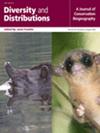Rhodolith Beds in Brazil—A Natural Heritage in Need of Conservation
Abstract
Aim
Brazil harbours the largest known extent of rhodolith beds (RBs) in the world, a habitat whose ecological and economic importance have been widely overlooked. This creates a dire situation that is likely to worsen with the rapidly expanding human activities, considering that less than 5% of Brazil's ocean area is fully protected. We assessed the importance of Brazilian RBs for supporting biodiversity, at a country-wide level, and identified multi-criteria hotspots that, in face of lack of protection and presence of anthropogenic threats, could safeguard conservation seascapes across Southwestern Atlantic waters.
Location
Southwestern Atlantic Ocean.
Methods
We performed a systematic review of studies on Brazilian RBs to retrieve information regarding their spatial distribution and associated biodiversity. Multi-criteria hotspots were identified based on the areas where high species diversity co-occurs with a high presence of endemic, threatened and commercially important species. Furthermore, we assessed how well RBs are covered by marine protected areas (MPAs), as well as their spatial overlap with multiple threats.
Results
Existing records for Brazilian RBs indicate > 1000 different species, mostly fish and algae, including significant numbers of endemic, threatened and commercially important species. Most of the RBs are either unprotected or only partially protected, including the majority of the biodiversity hotspots identified by our analysis. Among the main potential threats to RBs, bottom trawling ranks highest, while the expansion of seabed mining and oil and gas activities may sharply increase the risk of cumulative impacts on RBs in the near future.
Main Conclusions
Our large-scale quantitative assessment confirms the significant role of RBs as biodiversity hotspots. This information could be leveraged to help meet the twin goals of RB conservation, through the establishment of highly-protected MPAs in hotspot areas, and their sustainable use through an ecosystem-based approach that accounts for vulnerabilities of RBs to multiple threats.


 求助内容:
求助内容: 应助结果提醒方式:
应助结果提醒方式:


